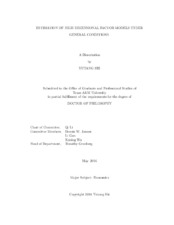| dc.contributor.advisor | Li, Qi | |
| dc.creator | Shi, Yutang | |
| dc.date.accessioned | 2016-07-08T15:10:05Z | |
| dc.date.available | 2016-07-08T15:10:05Z | |
| dc.date.created | 2016-05 | |
| dc.date.issued | 2016-03-02 | |
| dc.date.submitted | May 2016 | |
| dc.identifier.uri | https://hdl.handle.net/1969.1/156890 | |
| dc.description.abstract | High dimensional factor models have drawn attention in both empirical and theoretical studies. Correctly specifying the number of factors (r) is a fundamental issue for the application of factor models. We develop an econometric method to estimate the number of factors in factor models of large dimensions where the number of factors is allowed to increase as the two dimensions, cross-section size (N) and time period (T) increase. Using similar information criteria as proposed by Bai and Ng (2002), we show that the number of factors can be consistently estimated using the criteria. We propose a new procedure that avoids overestimating the number of factors while allowing for one to search for possible number of factors over a wide range of positive integers so that it also avoids underestimation of the number of factors. We conduct Monte-Carlo simulation to investigate the finite sample properties of the proposed approach.
The factor loadings are commonly estimated under the presupposition that they do not depend on time. However, this presumption is easily challenged by structural changes or regime shifts. We investigates high dimensional factor models with structural instability in factor loadings. Our inquiry focuses on how to estimate the unknown common break point and derive its limiting distribution. The least squares method is used to estimate the break point in factor loadings. Several competing methods are compared in the simulation. The results show that our proposed approach outperforms other methods. We further propose a new framework to derive the limiting distribution for the estimated change point. The limiting distribution of the estimated break point is more complex than that of the conventional panel data models, because both factors and factor loadings are unobservable. We show that the estimated factors and estimated factor loadings influence the limiting distribution. Based on the limiting distribution of the estimated break point, one can construct confidence intervals of the underlying true break point. Bootstrap method is also studied. We apply the method to the study of structural changes in financial asset returns and in macroeconomic data. | en |
| dc.format.mimetype | application/pdf | |
| dc.language.iso | en | |
| dc.subject | principal components | en |
| dc.subject | factor analysis | en |
| dc.subject | increasing number of factors | en |
| dc.subject | information criteria | en |
| dc.subject | structural change | en |
| dc.subject | two-sided random walk | en |
| dc.subject | limiting
distribution | en |
| dc.subject | asset returns | en |
| dc.subject | macroeconomics | en |
| dc.title | Estimation of High Dimensional Factor Models Under General Conditions | en |
| dc.type | Thesis | en |
| thesis.degree.department | Economics | en |
| thesis.degree.discipline | Economics | en |
| thesis.degree.grantor | Texas A & M University | en |
| thesis.degree.name | Doctor of Philosophy | en |
| thesis.degree.level | Doctoral | en |
| dc.contributor.committeeMember | Jansen, Dennis W. | |
| dc.contributor.committeeMember | Gan, Li | |
| dc.contributor.committeeMember | Wu, Ximing | |
| dc.type.material | text | en |
| dc.date.updated | 2016-07-08T15:10:05Z | |
| local.etdauthor.orcid | 0000-0002-5519-3781 | |


